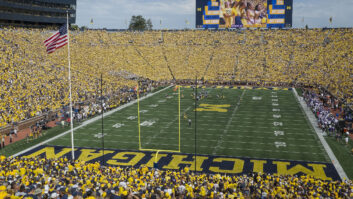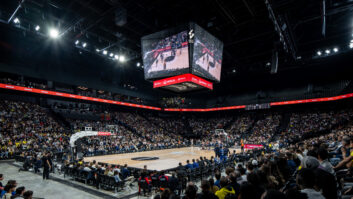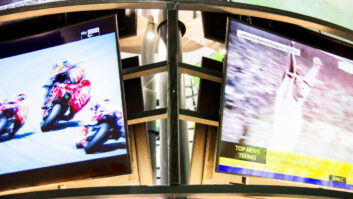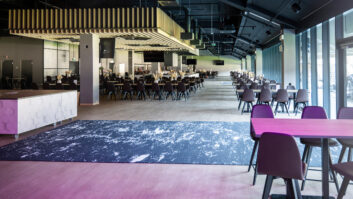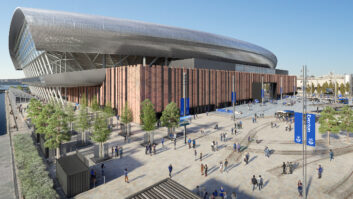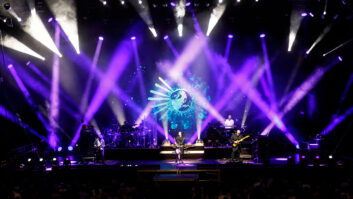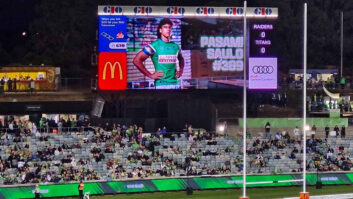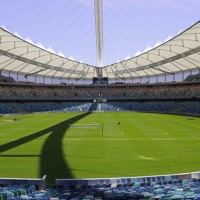
Durban’s new football stadium is not only a World Cup soccer venue, it has been designed to be capable of being an Olympic venue. We report on how the visual technology is being handled
As IE reported in April, the 2010 FIFA World Cup will take place in 10 different stadiums across South Africa. In Durban, the newly built 70,000-seat Moses Mabhida stadium will host five group games, one second round game and a semi-final.
Located in KwaZulu Natal, the facility also includes a High Performance Centre, a campus for sporting and development academies and a smaller indoor arena. And, while the seating capacity will be downgraded from 70,000 to 54,000 after the tournament, the stadium can also be upgraded to an 85,500-seater, ensuring that Durban has the facilities in place to host the Olympic Games. The structure is dominated by a 106m high, 350m long free-span steel stadium arch, the top of which can be accessed via cable car to a viewing platform.
The €1.8 million AV contract for Moses Mabhida was awarded to System Solutions, following the success of its work at Johannesburg’s 95,000-capacity Soccer City Stadium, which will host the final.
The video requirement at the stadium was for high-definition IPTV, a digital signage video distribution system as well as one large-format, high-resolution outdoor LED screen. The Christie Spyder X20 was released after the tender had been won, and so System Solutions was able to deploy it in this stadium.
Using 20MP processing, matrix switching and integrated source monitoring, the Spyder X20 has all the flexibility of a universal routing switcher. Its integrated source monitoring enables simultaneous, real-time, full frame rate monitoring of all inputs.
The input configuration comprises four feeds from the AV Stumpfl Wings Platinum 4 media server, four HD SDI feeds for the outside broadcast and pitch feeds, and two Blu-ray player inputs.
On the output stage, the X20 sends an XGA signal over fibre to the Lighthouse big screen and provides two RF Modulator feeds for the private suites, two HD IPTV encoders, an operator’s monitor and a source multiview.
Says senior video technician Mike Tempest: “In Durban we have gone for a more IPTV-based system [than at Soccer City] that displays a ‘Digital Signage’ channel, fed from an IPTV decoder, instead of multiple DS players.”
A Wings Platinum 4 server runs AV Stumpfl’s ISEO system for media control and digital signage. Unlike other media solutions, ISEO does not differentiate between media control system, signal routing and content management for digital signage. Instead, it is based on a decentralised architecture that allows all network users to communicate directly via Ethernet, on an equal footing with each other. AV Stumpfl says that this decentralised approach also helps to reduce the failure rate.
Central control
A large number of the 300 Sony monitors, ranging from kiosk to information and emergency monitors, as well as the huge Lighthouse LED scoreboard, will be controlled centrally by an operator from the AV production company. In addition to this, ISEO will also be responsible for the important tasks of signal preparation and distribution to all TV stations, as well as the entire media control system for the conference rooms.
Installing the many displays at the stadium required a diverse range of mounting solutions, from recessed fixed installs to ceiling and swing-arm installations – and involved a number of challenges. The lobbies have a distinct lounge atmosphere that required the displays to be recessed into false walls that were part of the design. “There are two challenges with such recessed installations,” observes Sean Stewart, managing director of System Solutions. “The displays needed to be easily accessible for service and maintenance. Secondly, the install needs to be exactly level as mounted within a frame. Each millimetre off, left or right, is noticeable right away.”
In the food and beverage areas, the power and signal outlets were already placed, but the displays over the food court entry needed to have the flexibility to be moved left and right whenever needed.
Both of these issues were addressed using Chief Mounts. “Chief Fusion mounts have a ClickConnect feature that works well for recessed applications that need to be easily accessible. This feature allows the display to be disconnected without tools and kicks out the bottom of the display 15º to allow for easy cable access,” says Stewart. “The Control Zone levelling feature was ideal because it provided an easy height and level adjustment of the display after installation.”
The open wall plate design left all the space necessary to place the mounts over existing power outlets in the food court area. For perfect positioning of the displays, a lateral shift feature allowed left or right movement once installed.
To complete the installation, the displays were easily secured to the mount with a padlock to protect against theft.
“Not only did Chief meet the specifications for the diverse requirements of these projects, the installations were completed in a quick and efficient manner and we got fantastic support. We are very pleased with the end result,” adds Stewart.
Summing up the project as a whole, he says: “It has been a privilege for us to be working in the two biggest stadiums for 2010. Moses Mabhida has been built as an Olympic Stadium, and its impressive arch has already become an iconic landmark in the area.”
